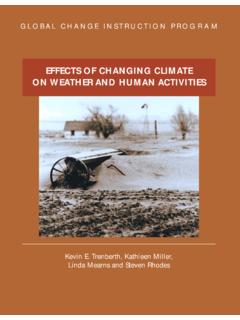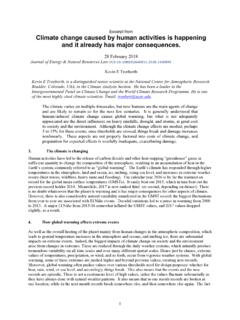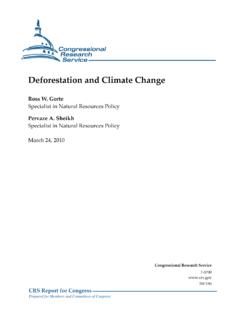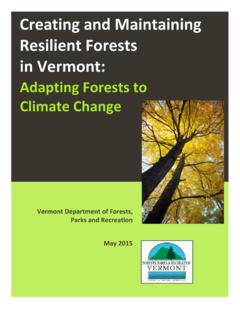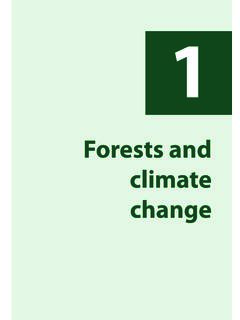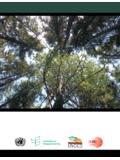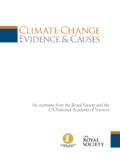Transcription of Forests and Climate Change: Forcings, Feedbacks and the ...
1 Forests and Climate change : Forcings, Feedbacks and the Climate Benefits of ForestsGordon BonanNational Center for Atmospheric ResearchBoulder, ColoradoGeography DepartmentUniversity of DenverDenver, ColoradoNovember 13, 2008 NCARN ational Center for Atmospheric ResearchBoulder, ColoradoAtmospheric general circulation models Atmospheric physics and dynamics Prescribed sea-surface temperature and sea ice Bulk formulation of surface fluxes without vegetation Bucket model of soil hydrologyOcean general circulation models Physics, dynamicsLand surface models Surface energy balance Hydrologic cycle Vegetation Global Climate models Atmosphere Land and vegetation Ocean Sea iceAtmospheric sciencesOceanographyAtmospheric & oceanic sciencesTerrestrial ecosystem models Biogeochemical cycles (C-N-P) Vegetation dynamics Wildfire Land use Earth system models Physics, chemistry, biology HumansEarth system scienceEcologyEvolution of Climate science(1970s)(1980s)(2000s)(1990s)(1990 s)
2 Ocean ecosystem models Biogeochemical cyclesNCARN ational Center for Atmospheric ResearchBoulder, Colorado Continued expansion of capability to simulate ecological, hydrological, and biogeochemical forcings and feedbacksin the earth system Increased emphasis on ability to conduct impacts, adaptation, and mitigationresearch Requires an integrated assessment modelingframework Human systems (land use, urbanization, energy use) Biogeochemical systems (C-N-P, trace gas emissions, constituent tracing, isotopes) Water systems (water resource management, freshwater availability, water quality) Ecosystems (disturbance, vulnerability, goods and services)Our researchThe land surface as the critical interface through which people affect, adapt to, and mitigate global environmental change (IPCC 2007)NCARN ational Center for Atmospheric ResearchBoulder, ColoradoClimate of the 20th centuryHegerl et al.
3 (2007) in Climate change 2007: The Physical Science Basis, Solomon et al., Eds., 663-745 Natural forcings only Anthropogenic and natural forcings Anthropogenic forcingsGreenhouse gases Sulfate aerosolsBlack carbon aerosolsOzoneIt is extremely unlikely (<5%) that the global pattern of warming during the past half century can be explained without external forcing , and very unlikely that it is due to known natural external causes aloneNatural forcingsSolar variability Volcanic aerosolsNCARN ational Center for Atmospheric ResearchBoulder, ColoradoAnthropogenic land useAgroecosytems Albedo Bowen ratio Infiltration/runoff Soil water holding capacity Atmospheric CO2 Nitrogen cycle DustFoley et al. (2005) Science 309:570-574 NCARN ational Center for Atmospheric ResearchBoulder, ColoradoSchaeffer et al.
4 (2006) GBC, 20, Reforestation might be chosen as an option for the enhancement of terrestrial carbon sequestration or biofuel plantations may be used as a substitute for fossil fuelsLand management mitigation policiesExcess agricultural land converted to carbon storage or biofuels2100 land management, IPCC A1B scenarioGreen = carbon plantationsGreen + red = biofuel plantationsCarbon plantations and biofuel plantations reduce atmospheric CO2, leading to coolingCarbon plantations have lower albedo than biofuels, leading to warmingMaize/Poplar/SwitchgrassNCARN ational Center for Atmospheric ResearchBoulder, ColoradoBonan (2008) Science 320:1444-1449 Forests and Climate changeContrast the biogeophysical (albedo, evapo-transpiration) effects of land cover change with the biogeochemical effects (carbon)
5 NCARN ational Center for Atmospheric ResearchBoulder, ColoradoThe Climate systemClimate models use mathematical formulas to simulate the physical, chemical, and biological processes that drive Earth s climateA typical Climate model consists of coupled models of the atmosphere, ocean, sea ice, and landLand is represented by its ecosystems, watersheds, people, and socioeconomic drivers of environmental changeThe model provides a comprehensive understanding of the processes by which people and ecosystems affect, adapt to, and mitigate global changeNCARN ational Center for Atmospheric ResearchBoulder, ColoradoBonan (2008) Science 320:1444-1449 The Community Land ModelFluxes of energy, water, and carbon and the dynamical processes that alter these fluxesOleson et al.
6 (2004) NCAR/TN-461+STRO leson et al. (2008) JGR, 113, ckli et al. (2008) JGR, 113, Center for Atmospheric ResearchBoulder, ColoradoCLM represents a model grid cell as a mosaic of up to 6 primary land cover types. Vegetated land is further represented as a mosaic of several plant functional typesBonan et al. (2002) GBC, 16, surface land cover and plant functional typesCrop in longitude (~200 km) in latitude (~200 km)NCARN ational Center for Atmospheric ResearchBoulder, ColoradoGlobal land useLocal land use is spatially heterogeneousNSF/NCAR C-130 aircraft above a patchwork of agricultural land during a research flight over Colorado and northern MexicoGlobal land use is abstracted to the fractional area of crops and pastureFoley et al.
7 (2005) Science 309:570-574 NCARN ational Center for Atmospheric ResearchBoulder, ColoradoComparison of 6 EMICs forced with historical land cover change , 1000-1992 Brovkin et al. (2006) Climate Dynamics 26:587-600 Mean annual air temperature, NH ( C)Northern Hemisphere annual mean temperature decreases by to C relative to the pre-industrial eraLand use forcing of climateThe emerging consensus is that land cover change in middle latitudes has cooled the Northern Hemisphere (primarily because of higher surface albedo in spring)NCARN ational Center for Atmospheric ResearchBoulder, ColoradoFuture IPCC SRES land cover scenarios for NCAR LSM/PCMF uture land cover change Feddema et al. (2005) Science 310:1674-1678 A2 Widespread agricultural expansion with most land suitable for agriculture used for farming by 2100 to support a large global populationB1 - Loss of farmland and net reforestation due to declining global population and farm abandonment in the latter part of the centuryNCARN ational Center for Atmospheric ResearchBoulder, ColoradoSRES B1 SRES A221002050 change in temperature due to land cover Feddema et al.
8 (2005) Science 310:1674-1678 A2 Widespread agricultural expansion with most land suitable for agriculture used for farming by 2100 to support a large global populationB1 - Loss of farmland and net reforestation due to declining global population and farm abandonment in the latter part of the centuryLand use choices affect climateFuture land cover change NCARN ational Center for Atmospheric ResearchBoulder, ColoradoEffect of Climate change on carbon at 2100 of cumulative anthropogenic carbon emissionsThe amount of carbon stored in the atmosphere increases in each model compared with the comparable simulation without Climate -carbon cycle feedback , while the land carbon storage decreasesClimate-carbon cycle feedbackAll models have a positive Climate -carbon cycle feedback .
9 The magnitude of this feedback ranges from 20 ppm to >200 ppmClimate and carbon cycleFriedlingstein et al. (2006) J Climate 19:3337 3353 With carbon cycle- Climate feedbackWithout carbon cycle- Climate feedbackNCARN ational Center for Atmospheric ResearchBoulder, ColoradoThere is a net flux of carbon to the atmosphere from changes in land use Tropical deforestation releases carbon Temperate reforestation stores carbon Land use and carbonSettlementanddeforestationsurround ingRioBranco,Brazil(10 S,68 W)intheBrazilianstateofAcre,neartheborde rwithBolivia. Thelargeimagecoversanareaof333kmx 333km.(NASA/GSFC/LaRC/JPL)NCARN ational Center for Atmospheric ResearchBoulder, ColoradoA2B1 BiogeochemicalA2 large warming; widespread deforestationB1 weak warming; less tropical deforestation, temperate reforestationNet effectA2 BGC warming offsets BGP coolingB1 moderate BGP warming augments weak BGC warmingBiogeophysicalA2 cooling with widespread croplandB1 warming with temperate reforestationIntegrated land cover change (2100)Sitch et al.
10 (2005) GBC, 19, ( C)NCARN ational Center for Atmospheric ResearchBoulder, ColoradoBonan (2008) Science 320:1444-1449 Forests and Climate changeMultiple competing influences of land cover changeCredit: Nicolle Rager Fuller, National Science FoundationNCARN ational Center for Atmospheric ResearchBoulder, ColoradoNeedleleaf evergreen forestBroadleaf deciduous forestMixed forestOpen shrublandWoody freeSnow coveredSnow freeSnow coveredForestNon-forestJin et al. (2002) GRL, 29, direct beam albedo (40 N and 50 N) Barlage et al. (2005) GRL, 32, masking of snow albedoMaximum albedo snow-covered landColorado Rocky MountainsForests have lower albedo during winter than other snow-covered landNCARN ational Center for Atmospheric ResearchBoulder, ColoradoJackson et al.

